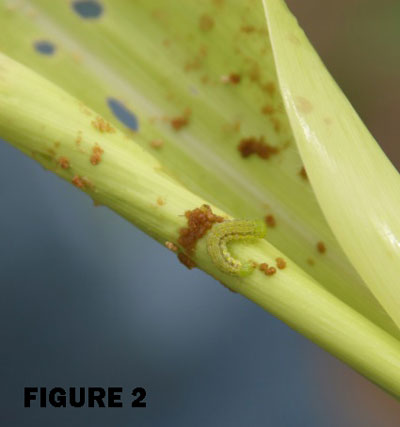- Corn earworm identification based solely on color can be difficult as larval color is highly variable.
- Corn earworm larvae feed in the whorl, silks and inside corn ears.
- Once the larvae enter the corn ears, control with insecticides is difficult and probably not economically feasible for field corn.
- Insecticide applications may be considered in the whorl stage if economic thresholds are met (non-Bt corn).
- A number of Bt commercial available corn varieties provide acceptable control of corn earworm.
- Integrated management programs are key to delay the onset of corn earworm resistance to Bt traits and preserve Bt crops as viable management tools.
Identification and Life Cycle
Larvae of corn earworm can be green, yellow, dark brown and even light purple in color (Fig. 1). Three or four sets of alternating dark and light stripes run the length of the larval body. The head capsule is orange in color. Dark tubercles are found along their backs and sides. The skin is coarse in texture with black spines covering the surface of their body. This latter is one of the key characteristics that distinguish them from other striped larvae. When disturbed they curl into a C-shape. Adults are grayish-brown moths with irregular dark gray lines on the front wings and a dark area near the wing tip.
Corn earworms overwinter as pupae in the southern states. In early spring corn earworm adults (moths) emerge and migrate north to the Midwest/ Corn belt region in early May. Historically there have been two generations per year in the Midwest and multiple generations in areas with warmer climates (south). Adult females of the first generation lay eggs singly in the whorl while the second generation females lay eggs on corn silks. One single female can lay up to 1000 eggs. However because the larvae are cannibalistic only one larva is typically found per ear. Once larvae find the ear they continue feeding there and move very little. After a few weeks, full grown larvae drop to the soil and burrows belowground to pupate. Ten to fourteen days later a new corn earworm adult emerges.
Damage
Although the first generation larvae that feed in the whorl cause some defoliation of the unfurled leaves (Fig. 2), the second generation is likely the most damaging one. Corn at VT to R1 is most attractive to egg laying by females. Second generation larvae may cause damage to the tassel, silks and kernels. Corn earworms enter the ear through the silk channel. As silks dry, corn earworms begin to feed on tip kernels (Fig. 3). This initial feeding can provide an entry point for secondary pests such as sap beetles and pathogenic fungus that produce mycotoxins.
Scouting
It is recommended to scout at R1 or when significant moths are captured in the pheromone traps. The presence of large numbers of eggs on fresh corn silks indicates the potential for damaging populations. The least destructive way to determine corn earworm presence in the ear is by sampling the silk. If no corn earworm damage is found, the silks will remain attached when pulled back lightly. However if silks can be pulled off easily with light pressure or if they are not attached, it can indicate that corn earworm larvae are present or that they have caused damage.
Management
The adoption of Bt corn varieties has made corn earworm management a lot easier than it was in the past. A number of Bt commercial available corn varieties provide acceptable control of corn earworm as well as other Lepidoptera pests and western corn rootworm. Consult your local dealer for a list of available products in your area.
Be aware that just as with insecticides, insects have the ability to develop tolerance to Bt traits. Corn earworms (and any insect pest) that survive on Bt corn are more likely to carry resistant genes that can be passed on to the next generation. The use of refuge (non Bt plants) is very important to provide a breeding site for susceptible insects and delay the development of resistance. To preserve the efficacy of Bt traits follow an integrated pest management approach. When possible use an effective crop rotation to crops non-suitable for corn earworm feeding. If crop rotation is not feasible try switching from single Bt traits to pyramid trait products.
If the corn does not contain Bt traits that offer control against corn earworm, insecticide applications may be considered in the whorl stage if economic thresholds are met. Once the larvae enter the ears, control with insecticides is difficult and not economical as earworms are protected by the ear husk. Keep in mind that there have been reports of corn earworm resistance to pyrethroids but there are other insecticides that provide acceptable levels of control. For more information on insecticides labeled for corn earworm in field corn: http://entomology.unl.edu/insecticide-treatment-options-corn-earworm-field-corn
Contact your FS Crop Specialist for your agronomic information.


Figure 1: Color variability of corn earworm larvae (Source: www.maine.gov)
Figure 2: Corn earworm feeding on whorl leaves. (Source: GROWMARK, Inc.)
Figure 3: Corn earworm feeding on ear tip (Source: GROWMARK, Inc.)